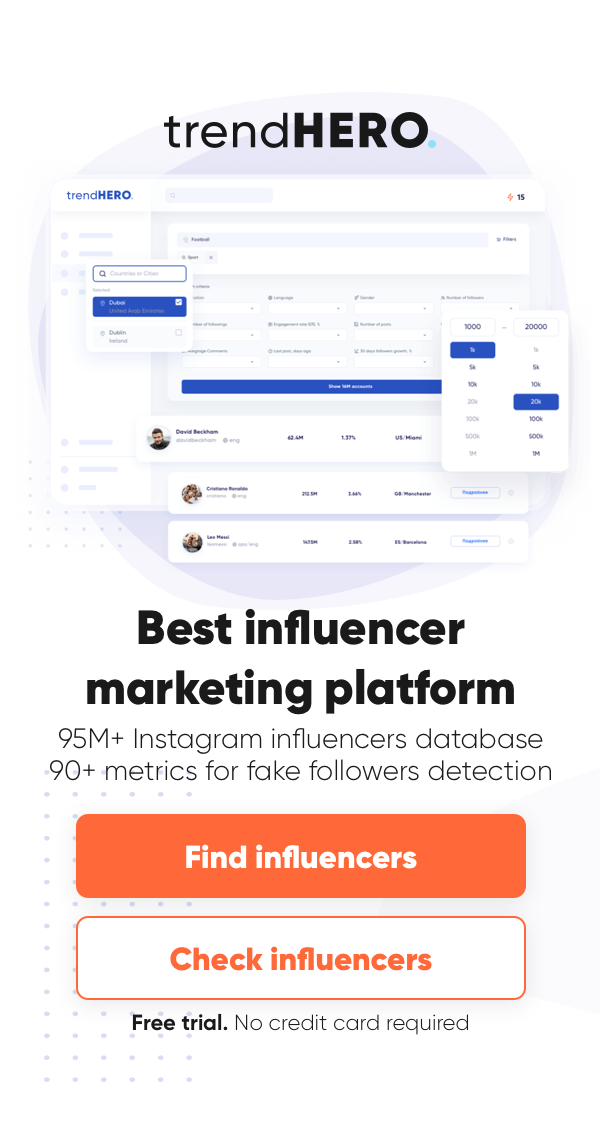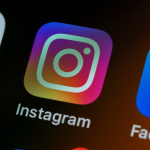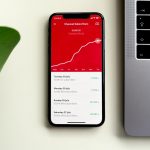You know the saying “in the right place at the right time” and might be wondering what it has to do with Instagram. Overall it’s all about well-written posts and stylish pictures, right?
Well, not really.
Post planning not only can drastically change your traffic but attract the target audience and increase sales. In other words, if you want to have an effective account, you need to know what is the best time to post on Instagram.
Why Do You Need to Find the Right Time for Instagram Posting?
It’s not enough anymore to just write and post in hopes that followers will read it sometime later. Each year platform’s algorithms become more and more complex, all for the better user experience. Which is a good sign for readers but a tricky thing for bloggers. In order to compete for readers’ attention, they have to adjust to trends, algorithms, and timing. It’s not a choice anymore, you have to ask yourself, “What time should I post on Instagram?”.
When Instagram just started gaining its popularity, all posts were coming up in chronological order. Later developers implemented a new algorithm, which started considering timing in a particular manner. Instead of showing posts chronologically, it individually sorts the most relevant and fresh posts.
Let’s have a close look at how the algorithm works.
The new video or photo posted on Instagram is shown to a certain percentage of followers. Usually, it’s around only 10%. That’s when the algorithm kicks in and determines how quickly followers react to it. Additionally, the system compares this post to all previous ones and evaluates the ‘success’ rate by analyzing average engagement and reaction speed. When the post performs well, it gets marked in the system as a qualitative content that people would like to see. As a result, it is shown to the larger group of users and gets a chance to appear on the page with suggested posts.
That’s why the right timing matters. Because posting during the night when everyone is sleeping will result in a minimum amount of likes as well as comments. In other words, you need to post when your followers and target audience is online, otherwise, the post will be lost to them.
What Time is Best to Post On Instagram?
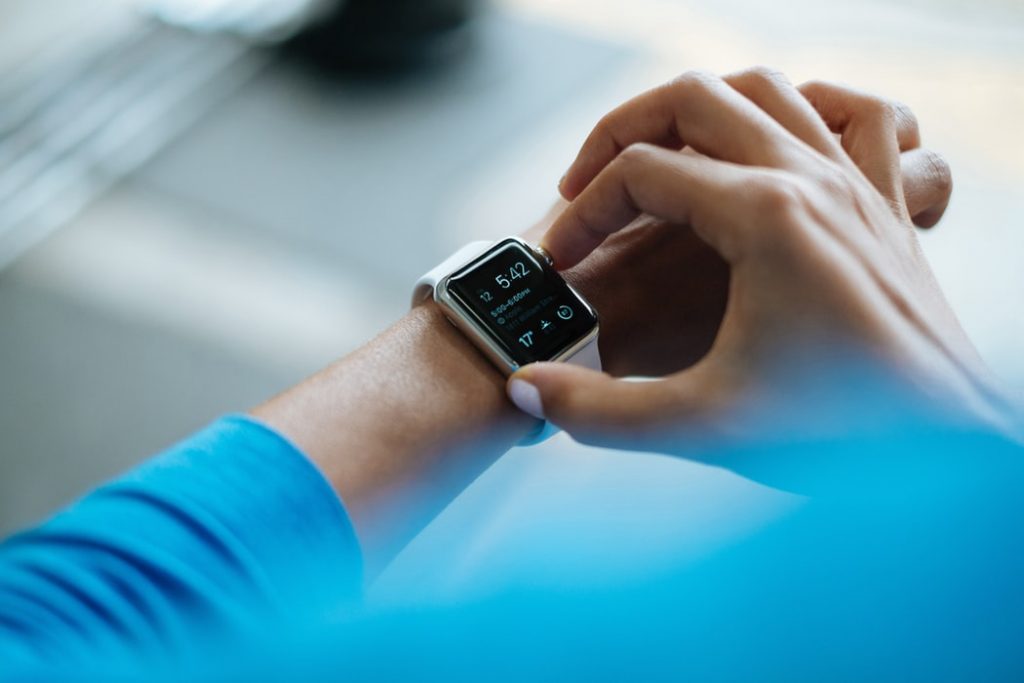
Unfortunately, there is no universal solution. There are so many different accounts filled with such a huge variety of content that it would be impossible to analyze all of it. Maybe later, when machine learning will be commonly used within social media platforms and available to regular users in the form of tools.
Until then the only right way to determine the best timing would be a careful analysis of each account. The best moment for posting would differ depending on the brand, its target audience, and time zones. The more variables you have the more complex analysis should be done.
But enough bad news, let’s see some facts about performance and traffic improvement. You should know which days are the best for posting, exact time frames, both best and worst time to post, have a look at statistics and how to determine when to post specifically for your account.
Day of the Week
The first step would be finding the perfect day. But there is a nuance in recent posting trends. The more popularity Instagram started to gain, the more content people expect to see.
If just a few years ago it was enough to post 3 or 4 times a week, today you should not only post daily but diversify your content in forms of stories, photos and even live streaming. Multiple reports prove that frequency matters and can actually improve the performance of your account by 30%.
So, you might think if I have to post every day, why bother finding out the perfect one, right? Well, there is at least one significant reason for that. That one day would be a perfect chance for a hard sell.
To find that right day of the week would be quite challenging. Statistics suggest that Wednesday shows the highest level of interaction, making this day a perfect chance for your sale to hit the bulls-eye.
Other days might be suitable as well depending on what type of account you have and who your followers are. When your goal is to attract some companies and businesses, you definitely should stick to weekdays, primarily Wednesday and Thursday. But if your account is purely entertaining and aimed at friends or random people, better days for interaction would be weekends.
Time of the Day
The next step would be to find the most active hours of the day. To make it easier, try to apply it to yourself. Think about your routine and mood dependencies. You will be surprised but those are quite similar to all other people. Here are some useful recommendations about optimal timing:
- 5:00 AM on weekdays has the highest activity level. That’s when most people wake up and check their social media.
- The period between 11:00 AM and 2:00 PM is even better. That’s when the second wave of engagement takes place which is also the most valuable one. It’s lunch break meaning that readers are more focused, compared to wake up time, and happy after food consumption.
- 3:00 PM to 5:00 PM is also good but should be considered for a lighter content. That’s when people start getting tired at work and check their Instagram accounts for small mental refreshments.
- If you plan to post on the weekend, do it on Saturday morning between 9:00 and 11:00 AM. That’s when people are attentive enough and relaxed eating brunch or hanging out with friends and family.
Time Zones
Another aspect of perfect timing depends on how widely your target audience is spread geographically. If it is worldwide, the calculation doesn’t really need to be strict, except for posting frequency. In that case, the best solution would be to prioritize one location and make two posts with a 12-hour difference. If you prefer the hard way, you would have to make very accurate calculations and post the moment when one time zone is in early morning hours, while another one is having lunch.
However, when your followers are all in the same location, it’s critical to use that specific time zone as a basis for all posting calculations, even if the difference with your time zone is insignificant.
Here is a list of best posting times globally:
- Monday: 11 AM to 2 PM
- Tuesday: 8 AM to 7 PM
- Wednesday: 5 AM to 4 PM
- Thursday: 5 AM to 3 PM
- Friday: 5 AM to 10 AM; 1 PM to 3 PM
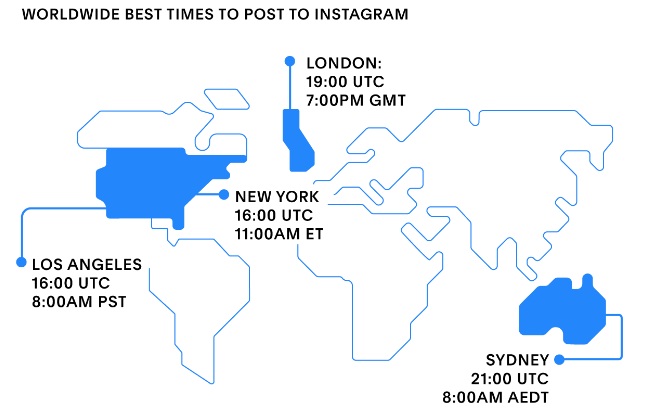
If your account is new and you plan to target the entire world, go with EST. It is the best way to balance between European and US audiences.
For example, the timeframe between 9 PM and 11 PM falls when Instagram users in Europe finish their workday, while users in the United States start lunch breaks. Which makes it a great opportunity for international business to target the audience globally.
Peak Times
Internet peak times work the same way as regular traffic. People use their commute time as a chance to surf through any updates. Therefore, posting during morning commute raises the chances for the post to be seen.
The next chance comes during lunch break. But that timeframe should be used efficiently because people tend to hurry and skip what is least interesting.
How to Find Your Best Time for Instagram Post
There are two ways to figure out the best time specifically for your account:
- Manually. You can track traffic when posting at various times and compare the results in a spreadsheet. Although it’s a good method but also a tricky one. Because the results would vary depending on content quality.
- Use an App. There are already a number of Apps that would do the job for you. They would analyze your content, audience, engagement level during various time frames, etc. They might not be free, but consider it as an investment into your business.
Analyze your and Competitors Statistics
Analytics is an integral part of any business, where Instagram is not an exception.
To maintain Instagram efficiency, you would need to monitor the most active hours, number of followers, their likes, comments, and story views. The exact numbers will help to determine how quickly the account is growing and engagement rate.
You might ask what is it all about? It’s simple. The statistics will show if posting time is well chosen and your audience engagement is growing. You might save yourself energy and money by avoiding posting content that ends up lost and untouched.
Check this graph for your and competitors accounts in trendHERO:
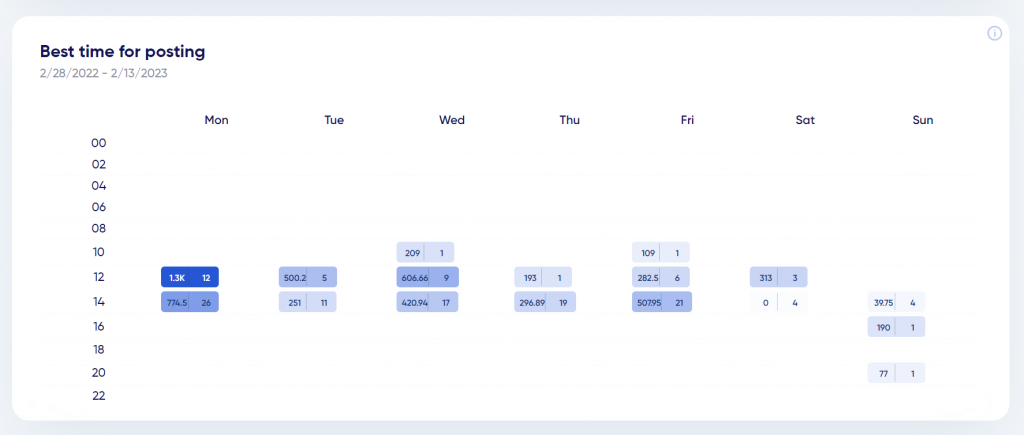
Here we see that this account has two main slots for posts 12 PM and 14 PM. They definitely should try some other slots:)
And keep in mind that it is not a one-time thing. You should analyze your statistics regularly, at least twice a month. Based on the results, you will see which subjects attract attention, what are the best times to post on IG, and which format to choose. It will help you notice if new trends are not working for your account or that it gets boring and irrelevant.
Make Experiments
Although it would be good to start with proven strategies and tactics, don’t be afraid to experiment once in a while. The safest would be trying different periods of the day, especially if you have several time zones and not sure which would work best.
You can create a few experimental schedules and try each once or twice a month. With the history of statistics, you will see which works better for your target audience and brand.
Best Instagram Times for Various Niches
Keep in mind that the best timing for posting is different for each business area.
For Technology Companies the best days for posting would be Wednesday and Thursday from 10:00 AM until 4:00 PM.
For Entertainment and Educational Accounts the best days would be Monday and Thursday. Followers’ engagement is usually high within all weekdays from 8:00 AM until 3:00 PM.
For Health and Non-Profit Organizations, the best day would be Tuesday. Although activity times will vary. For Health Organizations the best time frame would be from 9:00 AM until 4:00 PM on any weekday, while for Non-Profit Organizations it would lunch and evenings.
Worst Time for Posting
Usually, any posting on the weekend would experience less traffic. But if you have to post, by any means try to avoid Sunday. The engagement on that day is super low and shallow.
It would be better as well to stay away from posting on Saturday and Friday nights because most likely people will be out socializing.
Everything described above might look super complicated and hard to follow. But there is no easy way to run a business and achieve success, not in 2021. Even if your account is not monetized you still want your opinion and experience to be shared and heard, right?
So, if you want to have an engaging Instagram account and be the first one among competitors, keep analyzing your statistics, try different times for posting and learn your followers and their habits.
Instagram Engagement Rate Calculator For Free
Check any influencer's Engagement rate and analyze his or her followers growth history
Other free tools: Follower Count History, Instagram Follower Count, CPM Calculator
